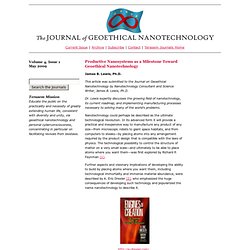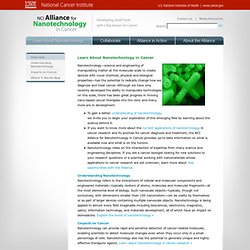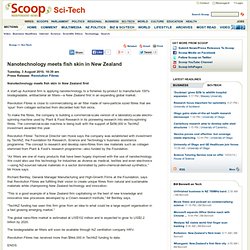

Nanotechnology and Nanomedicine Medical Devices and Applications. Nanotechnology involves the science and technology of devices and materials, such as drug delivery systems or electronic circuits, that are created on extremely tiny scales – as small as molecules and even atoms.

Nanotechnology also involves manipulation of structure matter at molecular levels, involving different fields and specialties such as chemistry, engineering, electronics, medicine and others. All of these fields of study and pursuit are concerned with bringing existing technologies down to a very tiny scale that is measured in, 'nanometers,' which is a billionth of a meter, or about the size of six carbon atoms in a row. The processes used both today and in the past in the creation of industrial products have involved pushing piles of millions of atoms together through mixing, grinding and heating, a process that is very imprecise.
Scientists are now able to pick up individual atoms and assemble them into structures, or cause particular chemical reactions. Cite This Document. Productive Nanosystems as a Milestone Toward Geoethical Nanotechnology, James B. Lewis, Ph.D. James B.

Lewis, Ph.D. This article was submitted to the Journal on Geoethical Nanotechnology by Nanotechnology Consultant and Science Writer, James B. Lewis, Ph.D. Dr. Nano. Moore. International Institute for Nanotechnology. Learn About Nanotechnology in Cancer. Nanotechnology—science and engineering of manipulating matter at the molecular scale to create devices with novel chemical, physical and biological properties—has the potential to radically change how we diagnose and treat cancer.

Although we have only recently developed the ability to manipulate technologies on this scale, there has been great progress in moving nano-based cancer therapies into the clinic and many more are in development. To gain a better understanding of nanotechnology, we invite you to begin your exploration of this emerging field by learning about the science behind it. Nanotechnology Today: Nanotechnology Podcast. Nanotechnology - A Review with an Australian PerspectiveTotal running time 32:18 mins, File size: 7.75Mb, File Type: mp3, BuckyBalls MPEG Movie 0:11 chemical vapor deposition is intercalated with copper to create a composite which exhibits good thermal properties ideal for chip cooling.

Photo: NASA Ames Center for Nanotechnology SYDNEY - 28th Sept 2006 - Marking a major milestone in the delivery of Nanotechnology related information; AZoNetwork and Nanotechnology Victoria (NanoVic) today announced the official release of the first in a series of Nanotechnology Reviews in a Podcast format. This initial Podcast provides a short history of the development of Nanotechnology and interviews several key players from within the Nanotech industry, research community and government to draw out their current views on the likely impact Nanotechnology will have on healthcare, materials and the environment.
Nanorisk.
Regulation. Nanotech Blog. The Dangers of Nanotechnology. PowerShow.com is a leading presentation/slideshow sharing website.

Whether your application is business, how-to, education, medicine, school, church, sales, marketing, online training or just for fun, PowerShow.com is a great resource. And, best of all, most of its cool features are free and easy to use. You can use PowerShow.com to find and download example online PowerPoint ppt presentations on just about any topic you can imagine so you can learn how to improve your own slides and presentations for free. Or use it to find and download high-quality how-to PowerPoint ppt presentations with illustrated or animated slides that will teach you how to do something new, also for free. Or use it to upload your own PowerPoint slides so you can share them with your teachers, class, students, bosses, employees, customers, potential investors or the world. For a small fee you can get the industry's best online privacy or publicly promote your presentations and slide shows with top rankings.
Human Enhancement and Nanotechnology. By Jacob Heller and Christine Peterson The long-term goal of nanotechnology is to be able to fully manipulate molecular and atomic structures.

Since humans are made of the same basic building blocks as the natural world, nanotechnology will probably enable the ability to change human tissues and cells at the molecular level. This will open doors in medicine thought impossible, and it will enable us to extend the length and quality of human life. It will also open the door to "enhancements" of the body — better IQ, appearance, and capabilities. These enhancements will undoubtedly benefit many, but they also bring up important moral, ethical, and legal questions that human society has not yet had to face.
Nanotechnology would likely allow for an enormous array of human enhancements and medical treatments. There is a wide spectrum of positions that are taken in the human enhancement debate. Some worry that human enhancements may create undesirable pressures to enhance. Nanotechnology meets fish skin in New Zealand. Nanotechnology meets fish skin in New Zealand first A start-up Auckland firm is applying nanotechnology to a fisheries by-product to manufacture 100% biodegradable, antibacterial air filters—a New Zealand first in an expanding global market.

Revolution Fibres is close to commercialising an air filter made of nano-particle sized fibres that are ‘spun’ from collagen extracted from discarded hoki fish skins. To make the fibres, the company is building a commercial-scale version of a laboratory-scale electro-spinning machine used by Plant & Food Research in its pioneering research into electro-spinning fibres. The commercial-scale machine is being built with the support of $456,000 in TechNZ investment awarded this year.
Revolution Fibres’ Technical Director Iain Hosie says the company was established with investment by TechNZ, the Foundation for Research, Science and Technology’s business assistance programme.